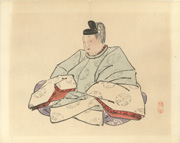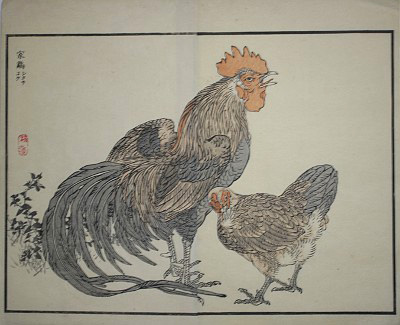Kōgyō Zushiki, Volume 4, 1883
IHL Cat. #713
BIOGRAPHY
Kōno Bairei 幸野楳嶺 (1844-1895)Sources: International Fine Print Dealers Association website http://www.printdealers.com/content/node/177; The Samurai Archives SamuraiWiki http://wiki.samurai-archives.com/index.php?title=Kono_Bairei and as footnoted.
 Kono Bairei (undated photo) | Born March 3, 1844 in Kyoto, and originally named Yasuda Bairei, Kōno Bairei was one of the leading practitioners of the ukiyo-e school devoted to pictures of birds and flowers (kacho-ga) in the Meiji period. Unlike the majority of ukiyo-e artists, he was trained as a classical Japanese painter. As a child, Bairei studied with Nakajima Raishō (1796-1871), a Maruyama school artist, and in his late twenties, with Shiokawa Bunrin (1808-1877) of the Shijō school.1 In 1873, he was invited to show his work at the second Kyoto Exposition and he would go on to show at other government sponsored expositions. Through these expositions Bairei attracted the attention of the abbot of Higashi Honganji in Kyoto, Ōtani Kōshō, who patronized Bairei and took him along on journeys to Kyushu in 1877 and the Kantō in 1885. Along with Kubota Beisen (1852-1906)2, Mochizuki Gyokusen (1834-1913) and a few others, he co-founded the Kyoto Prefectural Painting School in 1878. The Kyoto University of Arts which operates today has its origins in this school. Bairei headed the Northern School for a brief time, before a |
In 1886, along with Kubota Beisen, he founded the Kyoto Young Painters Study Group, aimed at helping train and promote young painters with a focus on talent rather than lineage. The group was successful for a brief time, but controversy once again erupted and the group was dissolved. Subsequently Bairei left Kyoto for Nagoya for much of the remainder of the decade.
Returning to Kyoto, Bairei collaborated with Beisen again, founding the Kyoto Art Association, launching one of the city's first arts journals, and establishing the first major competitive painting exhibition in the city, the "Exhibition of New and Old Art," in 1895.
As one of the foremost artists of his day, Bairei had about 60 apprentices in his studio named Ryōuin-juku ('the atelier of the transcending cloud')3, including Kikuchi Hōbun, Kawai Gyokudō, Uemura Shoen, Takeuchi Seihō (1864-1942) (Bairei's most famous student) and the recently rediscovered Tsuji Kakō (1871-1931).4 He is said to have been a stern instructor and quite harsh at times.
Though at first woodblock prints were only an afterthought, Bairei eventually designed woodblocks for illustrated books and produced a number of series of prints, such as Bairei hyakuchō gafu (Bairei's Album of 100 Birds); Bairei kachō gafu (Bairei's Album Flowers and Birds) which depicted birds and flowers in the four seasons, and Bairei Gakan (Mirror of Bairei Paintings) which depicts animals, birds, insects, flowers, landscapes, Mt. Fuji and more. His kacho-ga and landscapes have been described as having "a faint touch of Western realism."5In February 1891, Bairei suddenly announced his retirement from the art world, and the next year he sent Landscape in Autumn to the World Fair held in Chicago. Later Bairei traveled with Bishop Kōshō of Higashi Honganji on the latter's preaching tour. In 1893 Bairei became a member of the Art Committee of the Imperial Household. In 1894 he was commissioned to paint murals in Higashi Honganji Tokyo, and died the next year upon completion of this work.6
1Background on Maruyama-Shijō school of art - The Maruyama school of painting derives from Maruyama Ōkyu (1733-95) who integrated the Kyoto decorative manner with a high degree of naturalistic realism. Aware of Western perspective, he advised his pupils to study directly from nature. The Shijō school of painting, founded by Matsumura Goshun (1752-1811), added a degree of poetic idealism to Ōkyu's realism. (Source: "One of Seiho's Lions," Eric van den Ing, Andon 61, Society for Japanese Arts, Leiden, 1999, p. 4.)
2 Beisen, eight year's younger than Bairei, was a student of Bairei's.
3 op. cit. Eric van den In.
4 "Kako Tsuji: Free from Schools with Zen's help," C. B. Liddell, Thursday, Feb. 8, 2007, The Japan Times Online
5 A Dictionary of Japanese Artists: Painting, Sculpture, Ceramics, Prints, Lacquer, Laurance P. Roberts, Weatherhill, 1976, p. 8.
6 "Bairei Kono and his work," Masahiro Misumi, 1937 online at http://www.tobunken.go.jp/~bijutsu/english/publications/bijutukenkyu/abstract/62.html
An American's Visit to Bairei's Studio
Source: Japan Day by Day, 1877, 1878-79, 1882-83 (Volume 2), Edward Sylvester Morse, Houghton Mifflin Co., 1917, p. 260, 261, 301.| Today (August 8) I visited the artist Bairei to employ him to make a copy of a picture he had painted for Rokubei, the potter, illustrating the process of pottery-making. I found Mr. Bairei, who is a teacher, in the midst of a class of pupils, who were busy with their work, all on the floor with their copies in front of them , many of them being boys of twelve or younger. Some of the older pupils, he told me, had been with him for ten years. The pupils come at eight o'clock in the morning, leaving at noon in the summer and at 5 P.m. in the winter, every day except Sunday, which has lately become a holiday. The price of tuition is thirty cents a month, and the teacher supplies paper, brushes, ink, colors, etc. In three years the pupils learn to copy well. The first lessons consist of simple lines, diaper work, and the like. The next year they paint flowers; after that mountains and scenery; and finally figures, first drawing drapery, then the nude figure from life. Some of the pupils come from the artisan class, such as potters and others whose occupations demand designs or decoration; the other pupils come from the samurai class. Mr. Bairei has twenty pupils in his daily class, besides a few who practice at their houses and bring their work to him once a week for criticism. After an interesting interview I rose from my knees. All the pupils immediately bowed low, and at the same time Mr. Bairei presented me with a large roll of paper which consisted of the exercises of the school for that day: beautiful drawings in strong, vigorous brush strokes of flowers, fruit, and boats. These drawings illustrate better than all the descriptions the methods of teaching and the proficiency of the young Japanese. I again visited Bairei's drawing-school and house, and for two hours enjoyed watching the deft way in which the pupils work. It seemed an awkward position to be down on the floor with knees bent under the body, yet Bairei told me that the pupils would hold this position for hours apparently without fatigue. The work consists in copying from other drawings. Much of the preliminary work is done by tracing and in every case a brush is used. The paper is not thin enough to see the drawing distinctly, and so it is lifted up at almost every touch of the brush. The paper is held down by a paper-weight at the head of the sheet. In beginning, the brush is filled with the paint, a proper point is made by trying the brush on another sheet, and if there is too much paint it is sucked out of the brush at the base, so as not to spoil the point. |
Bairei Hyakuchō Gafu and Hyakuchō Gafu Zokuhen
Source: Website of The Cowell-Thackray collection of Japanese prints and e-hon http://japaneseprints.wikispaces.com/Bairei%27s100+Birds and as footnoted.Bairei Hyakuchō Gafu (Bairei's Album of One Hundred Birds) was first published in three volumes in 1881 by Ōkura Magobei and was followed by three additional (supplemental volumes), in 1884, under the title Bairei Hyakuchō Gafu, Zokuhen 楳嶺百鳥画譜 續編 . The three volumes of each set were subtitled Sky (Ten 天); Earth (Chi 地) and People (Hito 人). The three supplemental volumes contained 83 woodblocks.
Writing in 1897, Edward Strange praised Hyakuchō Gafu as “perhaps the best illustrations of bird-life ever cut on wood. They are printed each from six or seven blocks, the shading even of the drawing being to some extent thus provided for, instead of having been left to the skill of the printer."1
1 Japanese Illustration: A History of the Arts of Wood-cutting and Colour, Edward Fairbrother Strange, London, G. Bell and sons, 1897, p. 105.
Descriptive Information Bairei Hyakuchō Gafu
Source: Website of Baxley Stamps http://www.baxleystamps.com/litho/meiji/1881060329.shtml
Volume 1 Sky (Ten 天) - 36 different birds depicted on 43 pages (21 1/2 folded pages) of color woodblocks (7 illustrations span two adjoining pages while 29 are single page). There are an additional 5 pages with Japanese text only (includes inside the covers). In total 48 pages or 23 folded pages and two single pages.
Volume 2 Earth (Chi 地) - 32 different birds depicted on 44 pages (22 folded pages) of color woodblocks (12 illustrations span two adjoining pages while 20 are single page). There are an additional 4 pages with Japanese text only (includes inside the covers). In total 48 pages or 23 folded pages and two single pages.
Volume 3 People (Hito 人) - no descriptive information found
| Hyakuchō Gafu Volume 2 Earth (Chi 地), 1881 cover | Hyakuchō Gafu Volume 3 People (Hito 人), 1881 cover |
| Hyakuchō Gafu Volume 1 Sky (Ten 天), 1881 unread birds | Hyakuchō Gafu Volume 2 Earth (Chi 地), 1881 Flamingo 紅鶴 | Hyakuchō Gafu Volume 3 People (Hito 人), 1881 Shrike伯劳 |
| Hyakuchō Gafu Zoku Hen, 1884 unknown volume Domestic chicken家鷄 | Hyakuchō Gafu Zoku Hen, 1884 unknown volume Japanese pheasant江南雉 | Hyakuchō Gafu Zoku Hen, 1884 unknown volume Crow 烏? |
An Ornothologist's View
Source: "A note on the Album of a hundred birds by Kono Bairei, a nineteenth century artist, with new light on the ‘Avid Indica’ of Collaert," A.S. Cheke appearing in Archives of Natural History (1983) 11 (2): p. 291-297.
Bairei, published two series of the Hundred Birds, the first in Meiji 14 (1881) and the second in Meiji 17 (1884). Each is in three volumes numbered in the traditional Japanese manner, ten (heaven), chi (earth) and jin (man). Most of the species depicted are Japanese wild birds, but there are some domesticated forms and imported cage-birds such as waders, larks, pipits, and buntings accompanied by a now obsolete Japanese name. Bairei sporadically gave the wrong name to perfectly well-drawn and identifiable birds.
Kōno Bairei appears to have worked largely from life. Unlike some of Bairei’s small birds, his large birds are mostly excellent, unmistakably identifiable and accurately to scale. [N]ot all the birds depicted are native to Japan. Most of the exotic forms are well-known cage-birds (for example, parrots, Java sparrows, Padda oryzivora, Bengalese finch, Lonchura (striata) ‘domestica’), albeit mostly shown in a free-flying setting, but some are less obviously so (Hypsipetes madagascariensis; an apparent Ficedula parva), so Bairei may have used foreign sources or even visited other countries himself.
Bairei Kachō Gafu
Sources: Website of J. Noel Chiappa http://mercury.lcs.mit.edu/~jnc/prints/bairei.html and website of Artelino Japanese Prints http://www.artelino.com/archive/archivesearch_show.asp?act=go&ars=46&cay=1&date_yyyy=0&exc=&evt=120&pp=5&pp1=1&ped=0&rp=44&rp1=1&rp2=44&lvl=2&sea=&sor=itm_artist_id%20DESC,%20itm_item_id%20DESC&sou=itemarchivem&suy=0&sut=0&tee=0Bairei Kachō Gafu 楳嶺花鳥画譜 (Bairei’s Book of Birds and Flowers) first published by Okura Magobei in Meiji 16 (1883) and then re-published posthumously in Meiji 32 (1899) by Ohkura Shoten, usedfour different engravers and was often bound into volumes, either as four separate volumes or two volumes for spring/summer and autumn/winter.
Bairei Ekagami
Note: Bairei Ekagami is often seen transliterated at Bairei Gakan.
1 Beisen, eight year's younger than Bairei, was a student of Bairei's.
2 "Kako Tsuji: Free from Schools with Zen's help," C. B. Liddell, Thursday, Feb. 8, 2007, The Japan Times Online
3 A Dictionary of Japanese Artists: Painting, Sculpture, Ceramics, Prints, Lacquer, Laurance P. Roberts, Weatherhill, 1976, p. 8.
4 "Bairei Kono and his work," Masahiro Misumi, 1937 online at http://www.tobunken.go.jp/~bijutsu/english/publications/bijutukenkyu/abstract/62.html
5 Japanese Illustration: A History of the Arts of Wood-cutting and Colour, Edward Fairbrother Strange, London, G. Bell and sons, 1897, p. 105.
last revision:



























